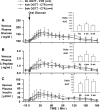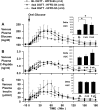Chronic consumption of a high-fat/high-fructose diet renders the liver incapable of net hepatic glucose uptake
- PMID: 20823448
- PMCID: PMC3006253
- DOI: 10.1152/ajpendo.00372.2010
Chronic consumption of a high-fat/high-fructose diet renders the liver incapable of net hepatic glucose uptake
Abstract
The objective of this study was to assess the response of a large animal model to high dietary fat and fructose (HFFD). Three different metabolic assessments were performed during 13 wk of feeding an HFFD (n = 10) or chow control (CTR, n = 4) diet: oral glucose tolerance tests (OGTTs; baseline, 4 and 8 wk), hyperinsulinemic-euglycemic clamps (HIEGs; baseline and 10 wk) and hyperinsulinemic-hyperglycemic clamps (HIHGs, 13 wk). The ΔAUC for glucose during the OGTTs more than doubled after 4 and 8 wk of HFFD feeding, and the average glucose infusion rate required to maintain euglycemia during the HIEG clamps decreased by ≈30% after 10 wk of HFFD feeding. These changes did not occur in the CTR group. The HIHG clamps included experimental periods 1 (P1, 0-90 min) and 2 (P2, 90-180 min). During P1, somatostatin, basal intraportal glucagon, 4 × basal intraportal insulin, and peripheral glucose (to double the hepatic glucose load) were infused; during P2, glucose was also infused intraportally (4.0 mg·kg(-1)·min(-1)). Net hepatic glucose uptake during P1 and P2 was -0.4 ± 0.1 [output] and 0.2 ± 0.8 mg·kg(-1)·min(-1) in the HFFD group, respectively, and 1.8 ± 0.8 and 3.5 ± 1.0 mg·kg(-1)·min(-1) in the CTR group, respectively (P < 0.05 vs. HFFD during P1 and P2). Glycogen synthesis through the direct pathway was 0.5 ± 0.2 and 1.5 ± 0.4 mg·kg(-1)·min(-1) in the HFFD and CTR groups, respectively (P < 0.05 vs. HFFD). In conclusion, chronic consumption of an HFFD diminished the sensitivity of the liver to hormonal and glycemic cues and resulted in a marked impairment in NHGU and glycogen synthesis.
Figures







Similar articles
-
MetAP2 inhibitor treatment of high-fat and -fructose-fed dogs: impact on the response to oral glucose ingestion and a hyperinsulinemic hyperglycemic clamp.Am J Physiol Endocrinol Metab. 2020 Apr 1;318(4):E514-E524. doi: 10.1152/ajpendo.00451.2019. Epub 2020 Jan 28. Am J Physiol Endocrinol Metab. 2020. PMID: 31990576 Free PMC article.
-
A high-fat, high-fructose diet accelerates nutrient absorption and impairs net hepatic glucose uptake in response to a mixed meal in partially pancreatectomized dogs.J Nutr. 2011 Sep;141(9):1643-51. doi: 10.3945/jn.111.145359. Epub 2011 Jul 20. J Nutr. 2011. PMID: 21775526 Free PMC article. Clinical Trial.
-
Bromocriptine mesylate improves glucose tolerance and disposal in a high-fat-fed canine model.Am J Physiol Endocrinol Metab. 2020 Jul 1;319(1):E133-E145. doi: 10.1152/ajpendo.00479.2019. Epub 2020 May 27. Am J Physiol Endocrinol Metab. 2020. PMID: 32459527 Free PMC article.
-
Hepatic glucose uptake and disposition during short-term high-fat vs. high-fructose feeding.Am J Physiol Endocrinol Metab. 2014 Jul 15;307(2):E151-60. doi: 10.1152/ajpendo.00083.2014. Epub 2014 May 27. Am J Physiol Endocrinol Metab. 2014. PMID: 24865981 Free PMC article.
-
Regulation of hepatic glucose uptake and storage in vivo.Adv Nutr. 2012 May 1;3(3):286-94. doi: 10.3945/an.112.002089. Adv Nutr. 2012. PMID: 22585902 Free PMC article. Review.
Cited by
-
Central Nervous System Control of Glucose Homeostasis: A Therapeutic Target for Type 2 Diabetes?Annu Rev Pharmacol Toxicol. 2022 Jan 6;62:55-84. doi: 10.1146/annurev-pharmtox-052220-010446. Annu Rev Pharmacol Toxicol. 2022. PMID: 34990204 Free PMC article. Review.
-
Animal models of obesity and diabetes mellitus.Nat Rev Endocrinol. 2018 Mar;14(3):140-162. doi: 10.1038/nrendo.2017.161. Epub 2018 Jan 19. Nat Rev Endocrinol. 2018. PMID: 29348476 Review.
-
Superior Glycemic Control With a Glucose-Responsive Insulin Analog: Hepatic and Nonhepatic Impacts.Diabetes. 2018 Jun;67(6):1173-1181. doi: 10.2337/db18-0099. Epub 2018 Mar 14. Diabetes. 2018. PMID: 29540491 Free PMC article.
-
MetAP2 inhibitor treatment of high-fat and -fructose-fed dogs: impact on the response to oral glucose ingestion and a hyperinsulinemic hyperglycemic clamp.Am J Physiol Endocrinol Metab. 2020 Apr 1;318(4):E514-E524. doi: 10.1152/ajpendo.00451.2019. Epub 2020 Jan 28. Am J Physiol Endocrinol Metab. 2020. PMID: 31990576 Free PMC article.
-
Bredemolic Acid Ameliorates Selected Liver Function Biomarkers in a Diet-Induced Prediabetic Rat Model.Can J Gastroenterol Hepatol. 2020 Feb 20;2020:2475301. doi: 10.1155/2020/2475301. eCollection 2020. Can J Gastroenterol Hepatol. 2020. PMID: 32149046 Free PMC article.
References
-
- Adkins-Marshall BA, Myers SR, Hendrick GK, Williams PE, Triebwasser K, Floyd B, Cherrington AD. Interaction between insulin and glucose-delivery route in regulation of net hepatic glucose uptake in conscious dogs. Diabetes 39: 87–95, 1990 - PubMed
-
- An Z, DiCostanzo CA, Moore MC, Edgerton DS, Dardevet DP, Neal DW, Cherrington AD. Effects of the nitric oxide donor SIN-1 on net hepatic glucose uptake in the conscious dog. Am J Physiol Endocrinol Metab 294: E300–E306, 2008 - PubMed
-
- Basu A, Basu R, Shah P, Vella A, Johnson CM, Nair KS, Jensen MD, Schwenk WF, Rizza RA. Effects of type 2 diabetes on the ability of insulin and glucose to regulate splanchnic and muscle glucose metabolism: evidence for a defect in hepatic glucokinase activity. Diabetes 49: 272–283, 2000 - PubMed
-
- Catena C, Giacchetti G, Novello M, Colussi G, Cavarape A, Sechi LA. Cellular mechanisms of insulin resistance in rats with fructose-induced hypertension. Am J Hypertens 16: 973–978, 2003 - PubMed
Publication types
MeSH terms
Substances
Grants and funding
LinkOut - more resources
Full Text Sources
Other Literature Sources
Medical
Miscellaneous

